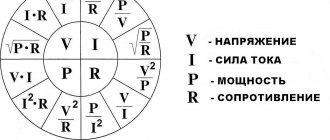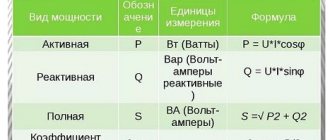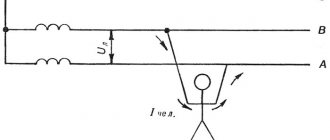Live electrical wires are constantly under a certain load. Therefore, the question very often arises: what is current density and how does it affect the quality of power supply. In fact, this value characterizes the degree of electrical load of the conductors. It allows you to prevent unnecessary losses when laying cable lines. When using high frequency devices, additional electrodynamic effects should be taken into account.
Types of electric current, flow conditions
Particles carrying a charge can move randomly through the conductor or move purposefully in a certain direction. In the second case, they talk about the presence of electric current. Its main characteristic is the presence of a displacement vector. The vector of current motion is identical to the direction of charged particles.
Chaotic and directed movement of charged particles
Important! The current flow can be constant or variable. In the first case, the flow of particles moves clearly in one direction in a straight line, without oscillations or disturbances. In the second, sinusoidal oscillations take place with a certain frequency. To transform (rectify) alternating electric current, special devices are used. In general, for the existence of a constant current, it is required that at one end of the conductor element there is always an excess of negatively charged particles, and at the other - a deficiency. A force is also required that will move these charges.
Alternating current, unlike direct current, does not require polarity. Unlike constant, it has a frequency - this is the number of changes in the direction of movement of particles per unit of time. In a standard household network, the number of such shifts is 50 per second. Various devices powered by rechargeable cells and batteries, as well as household appliances, laptops, and desktop computers consume constant electric current. The battery itself is a constant current generator, but it can be inverted into alternating current using special devices.
The current caused by the electric field is usually called conduction current. The elementary particles that carry charge differ among different types of conductor materials. In the case of metallic elements, these are free electrons; in some semiconductor materials, these are purposefully moving ions. In electrolytes (including those used in batteries), ions with positive and negative charges move in different directions. The latter is typical for all conductors that are liquids.
In a convection electric current, electrons move under the influence of inertia. Another type of current flows in vacuum conditions (this phenomenon is used in electronic light bulbs). The main characteristics of electric current are strength and current density.
Directed movement of electrons in a conductor
Introduction
Charges placed in an electrostatic field with a potential difference begin to move. This movement is called electric current, which is defined as the directed (ordered) movement of charged particles through any cross section of a conducting medium. The magnitude of this current depends on the resistance of the conducting medium to this movement of charges, which, in turn, depends on the cross-section of the conductor.
It should be noted that in electrical engineering the basic physical quantities, that is, the unit of measurement of electric current, ampere, and the unit of measurement of electric charge, coulomb, are often related to each other using a unit of length - the meter. And this is not without reason. The charge that flows through the cross-section of a conducting medium is often unevenly distributed. Therefore, it would be quite natural to determine the flow of charged particles through a unit cross section or unit length, in other words, to determine the current density
In this article, we will compare electric current and current density, and look at the importance of achieving, maintaining and measuring the required current density in various fields of electrical and electronic engineering.
Current Density and Power
Current work - how is it measured?
The work that the electric field does on sources of current motion can be characterized by power density (it is equal to the energy divided by the product of the volume of the conductor and the time period). The most common way for this power to be dissipated into external space as thermal energy. But some of it can be converted into mechanical energy (for example, during the operation of an electric motor) or into various types of radiation.
Definitions
Electricity
Electric current I
is defined as the directed movement of electrical charges along a line (for example, a thin wire), along a surface (for example, along a sheet of conductive material), or in a volume (for example, in an electronic or gas-discharge lamp). The SI unit of electrical current is the ampere, defined as the flow of electrical charges through a cross-section of a conductor at a rate of one coulomb per second.
Volume current density
Current Density
(also called volume current density) is
a vector field
in three-dimensional conducting space.
At each point in such space, the current density represents the total flow of electric charges per unit time passing through a unit cross section. Bulk density is indicated by the vector
symbol J. If we consider the ordinary case of a current-carrying conductor, the current in amperes is divided by the cross-section of the conductor. In SI, volumetric current density is measured in amperes per square meter (A/m²).
For example, if a current of 50 amperes flows along a powerful busbar of an electrical substation with a cross-section of 3 x 33.3 mm = 100 mm² = 0.0001 m², then the current density in such a conductor will be 500,000 A/m².
Linear current density
Sometimes in electronic devices, current flows through a very thin film of metal or a thin layer of metal that has a variable thickness. In such cases, researchers and designers are only interested in the width and not the total cross-section of such very thin conductors. In this case, they measure the linear current density
- a vector quantity equal to the limit of the product of the density of the conduction current flowing in a thin layer near the surface of the body and the thickness of this layer when the latter tends to zero (this is the definition according to GOST 19880-74). In the International System of Units (SI), linear current density is measured in amperes per meter and in the CGS system in oersteds. 1 oersted is equal to the magnetic field strength in a vacuum with an induction of 1 gauss. Otherwise, the linear current density is defined as the current per unit length in the direction perpendicular to the current.
For example, if a current of 100 mA flows in a thin conductor 1 mm wide, then the linear current density is 0.0001 A: 0.001 m = 10 amperes per meter (A/m). Linear current density is indicated by a vector symbol A
.
Surface current density
Linear current density is closely related to the concept of surface current density
, which is defined as the strength of the electric current flowing through the cross-section of a conducting medium of unit area and is denoted by the vector
symbol K. Like linear current density, surface current density is also a vector quantity, the magnitude of which represents the electric current through the cross-section of a conducting medium at a given location, and the direction is perpendicular to the cross-sectional area of the conductor. Such a conducting medium can be, for example, a current-carrying conductor, an electrolyte, or an ionized gas. In the SI system, current density is measured in amperes per square meter.
Vector or scalar?
Note that, unlike the vector current density, the current itself is a scalar quantity. This can be explained by the fact that current is defined as the number of charges moving per unit time
; therefore, it would be inappropriate to add direction to a quantity representing quantity per unit time. At the same time, the current density is considered in a volume with many cross sections through which the current passes, so it makes sense to define the current density as a vector or as a vector space. It can also be noted that the current density is a vector due to the fact that it is the product of the charge density and the speed of its movement anywhere in space.
Ohm's law
Magnetic field energy density
For a conductive medium with isotropic characteristics, this law has the following form:
j=E* σ,
where j is the density of the flowing electric current, E is the field strength at the point under consideration (a scalar quantity, like the previous one), and σ is the specific conductivity of the environment.
As for the work of the electric field for such a medium ( w ), it can be expressed by the following formulas:
w= E2* σ=j2/σ=p*j2 (p here is resistivity).
The expression for work in this case will take the form:
w=E* σ *E=j*p*j (E and j in this case are scalar quantities).
In a right-to-left matrix, a column vector is multiplied by a row vector and by a matrix. Tensor quantities p and σ generate their corresponding quadratic forms.
Definitions
Electricity
Electric current I
is defined as the directed movement of electrical charges along a line (for example, a thin wire), along a surface (for example, along a sheet of conductive material), or in a volume (for example, in an electronic or gas-discharge lamp). The SI unit of electrical current is the ampere, defined as the flow of electrical charges through a cross-section of a conductor at a rate of one coulomb per second.
Volume current density
Current Density
(also called volume current density) is
a vector field
in three-dimensional conducting space.
At each point in such space, the current density represents the total flow of electric charges per unit time passing through a unit cross section. Bulk density is indicated by the vector
symbol J. If we consider the ordinary case of a current-carrying conductor, the current in amperes is divided by the cross-section of the conductor. In SI, volumetric current density is measured in amperes per square meter (A/m²).
For example, if a current of 50 amperes flows along a powerful busbar of an electrical substation with a cross-section of 3 x 33.3 mm = 100 mm² = 0.0001 m², then the current density in such a conductor will be 500,000 A/m².
Linear current density
Sometimes in electronic devices, current flows through a very thin film of metal or a thin layer of metal that has a variable thickness. In such cases, researchers and designers are only interested in the width and not the total cross-section of such very thin conductors. In this case, they measure the linear current density
- a vector quantity equal to the limit of the product of the density of the conduction current flowing in a thin layer near the surface of the body and the thickness of this layer when the latter tends to zero (this is the definition according to GOST 19880-74). In the International System of Units (SI), linear current density is measured in amperes per meter and in the CGS system in oersteds. 1 oersted is equal to the magnetic field strength in a vacuum with an induction of 1 gauss. Otherwise, the linear current density is defined as the current per unit length in the direction perpendicular to the current.
For example, if a current of 100 mA flows in a thin conductor 1 mm wide, then the linear current density is 0.0001 A: 0.001 m = 10 amperes per meter (A/m). Linear current density is indicated by the vector symbol A
.
Surface current density
Linear current density is closely related to the concept of surface current density
, which is defined as the strength of the electric current flowing through the cross-section of a conducting medium of unit area and is denoted by the vector
symbol K. Like linear current density, surface current density is also a vector quantity, the magnitude of which represents the electric current through the cross-section of a conducting medium at a given location, and the direction is perpendicular to the cross-sectional area of the conductor. Such a conducting medium can be, for example, a current-carrying conductor, an electrolyte, or an ionized gas. In the SI system, current density is measured in amperes per square meter.
Vector or scalar?
Note that, unlike the vector current density, the current itself is a scalar quantity. This can be explained by the fact that current is defined as the number of charges moving per unit time
; therefore, it would be inappropriate to add direction to a quantity representing quantity per unit time. At the same time, the current density is considered in a volume with many cross sections through which the current passes, so it makes sense to define the current density as a vector or as a vector space. It can also be noted that the current density is a vector due to the fact that it is the product of the charge density and the speed of its movement anywhere in space.
Unit of measurement of electric current density
Allowable current for copper wires - current density in a copper conductor
To express the density value, the derivative is used from the units of current strength (Ampere) and cross-sectional area (square meter), as well as submultiples and multiples of the indicated ones. Density is usually measured in amperes divided by square meter (A/m2). Instead of the word “density”, “electric current saturation” is sometimes used.
Important! Because a quantity has a direction, it is categorized as a vector (or scalar). This vector runs along the axis of the electric current.
Introduction
Charges placed in an electrostatic field with a potential difference begin to move. This movement is called electric current, which is defined as the directed (ordered) movement of charged particles through any cross section of a conducting medium. The magnitude of this current depends on the resistance of the conducting medium to this movement of charges, which, in turn, depends on the cross-section of the conductor.
It should be noted that in electrical engineering the basic physical quantities, that is, the unit of measurement of electric current, ampere, and the unit of measurement of electric charge, coulomb, are often related to each other using a unit of length - the meter. And this is not without reason. The charge that flows through the cross-section of a conducting medium is often unevenly distributed. Therefore, it would be quite natural to determine the flow of charged particles through a unit cross section or unit length, in other words, to determine the current density
In this article, we will compare electric current and current density, and look at the importance of achieving, maintaining and measuring the required current density in various fields of electrical and electronic engineering.
Calculation formula
The value under consideration is inversely dependent on the cross-sectional dimensions (the larger the area, the lower the current density) and the time period of passage of the electric charge, and directly dependent on the magnitude of this charge.
This can be written like this:
j=Δq/ΔtΔS (q here is an elementary small charge, t is an infinitely small period of time, and S is the cross-sectional area).
Since the current force is expressed as the quotient of the charge and the time interval of its passage, the formula can be written as follows:
j=I/ΔS.
The formula for current density based on the parameters of moving charges will look like this:
j=q*n*V (V here is the speed, and n is the concentration of electron particles).
Introduction
Charges placed in an electrostatic field with a potential difference begin to move. This movement is called electric current, which is defined as the directed (ordered) movement of charged particles through any cross section of a conducting medium. The magnitude of this current depends on the resistance of the conducting medium to this movement of charges, which, in turn, depends on the cross-section of the conductor.
It should be noted that in electrical engineering the basic physical quantities, that is, the unit of measurement of electric current, ampere, and the unit of measurement of electric charge, coulomb, are often related to each other using a unit of length - the meter. And this is not without reason. The charge that flows through the cross-section of a conducting medium is often unevenly distributed. Therefore, it would be quite natural to determine the flow of charged particles through a unit cross section or unit length, in other words, to determine the current density
In this article, we will compare electric current and current density, and look at the importance of achieving, maintaining and measuring the required current density in various fields of electrical and electronic engineering.
4-vector current density
This designation from the theory of relativity is intended to generalize the phenomenon of density to the space-time continuum, operating in four dimensions. Such a four-vector includes a three-vector expression of the current density (scalar quantity) and the volumetric electric charge density. The use of a four-vector makes it possible to formulate electrodynamic equations in a covariant manner.
The quantity under consideration is necessary to describe the concentration and uniformity of distribution of charged microparticles over a conductor material in which one or another form of electric current exists. When operating with expressions containing a quantity, you must not forget about its scalarity.
1.3.27
An increase in the number of lines or circuits beyond what is required under the conditions of reliability of power supply in order to satisfy the economic current density is carried out on the basis of a technical and economic calculation. In this case, in order to avoid increasing the number of lines or circuits, it is allowed to exceed the normalized values given in table two times. 1.3.36.
Table 1.3.36. Economic current density
Feasibility calculations should take into account all investments in an additional line, including equipment and switchgear chambers at both ends of the lines. The feasibility of increasing the line voltage should also be checked.
These guidelines should also be followed when replacing existing wires with wires of larger cross-section or when laying additional lines to ensure economical current density as the load increases. In these cases, the full cost of all work on dismantling and installing line equipment, including the cost of apparatus and materials, should also be taken into account.
Security measures
The main safety rule when working with currents is that before any action you need to turn off the power supply. During the work process, you must also follow these recommendations:
- It is prohibited to repair a device connected to the electrical network.
- When carrying out work, a warning must be present on the electrical panel.
- Working with high voltage is only permissible with an assistant.
- It is necessary to monitor the insulation of each wire and monitor the grounding.
Voltage above 24 volts will be life-threatening. When working with voltages greater than this parameter, a special permit is required. When working, it is necessary to use special tools with a high level of protection.
Safety regulations
The use of electric current is varied, since life today cannot be imagined without it. It is necessary to understand the principles of its functioning in order to direct electricity in the right direction. Electric current flows according to the laws of physics used to create a variety of devices. To use it correctly, you need to become familiar with the basic electrical quantities.











